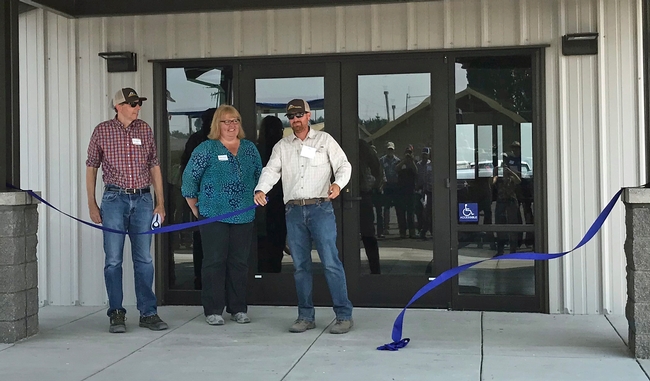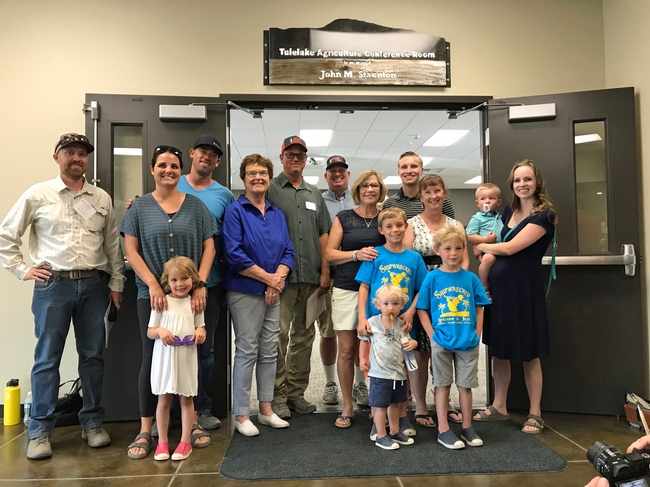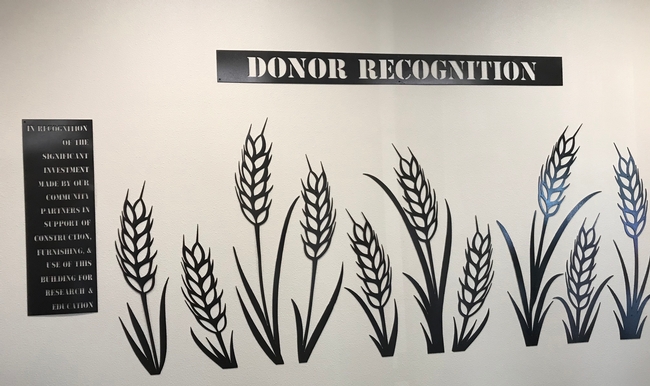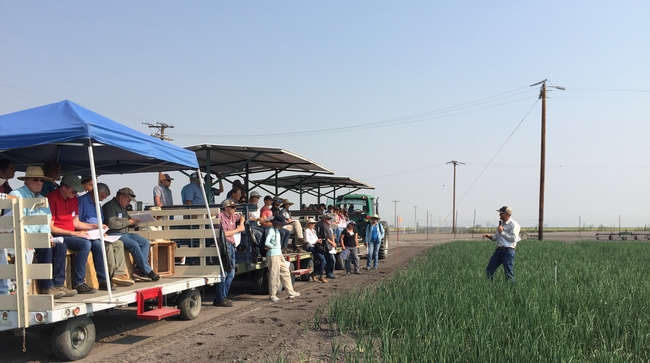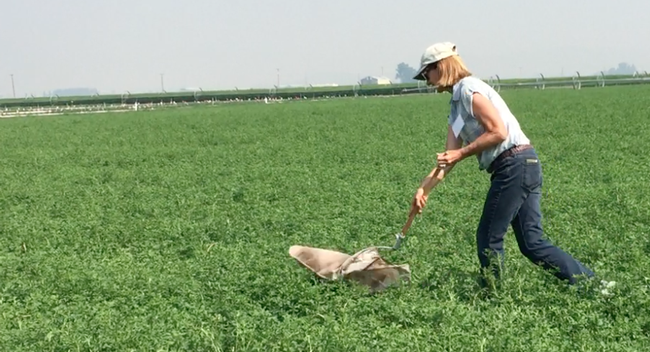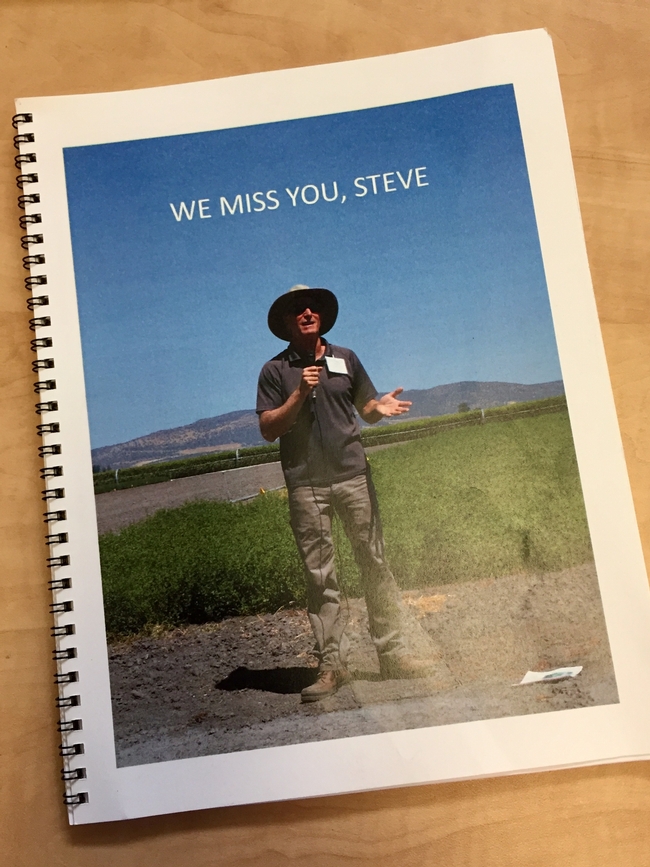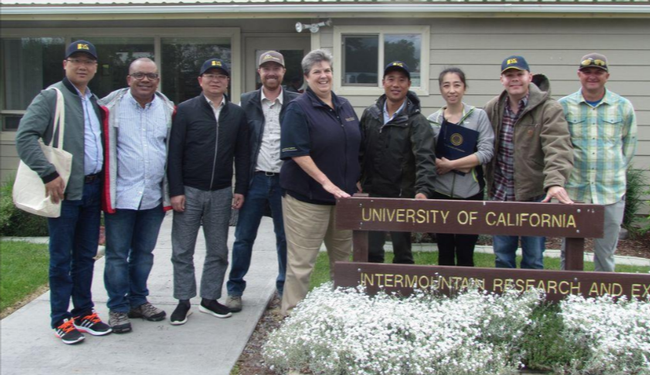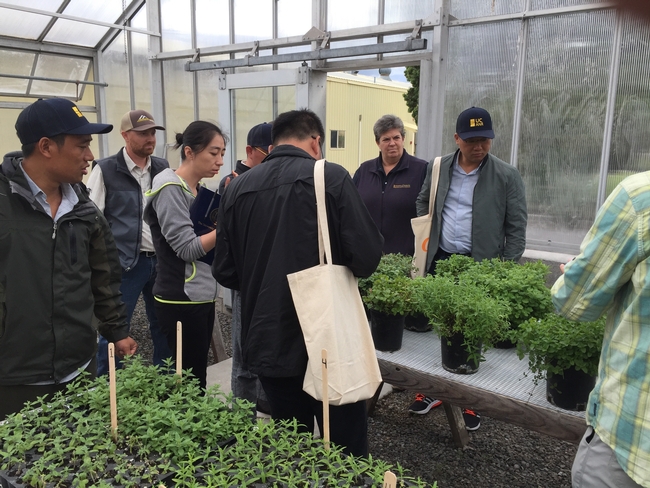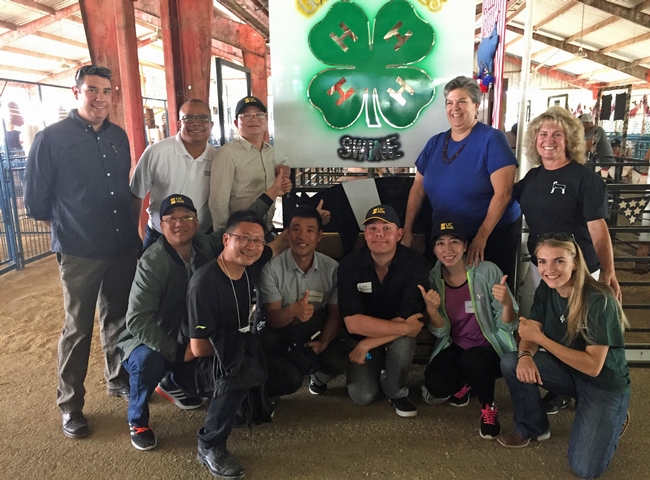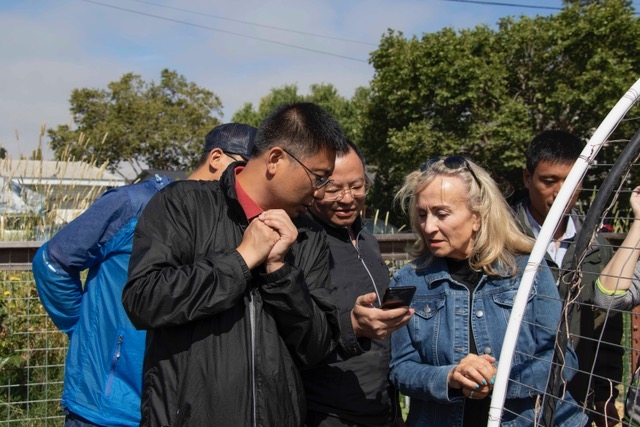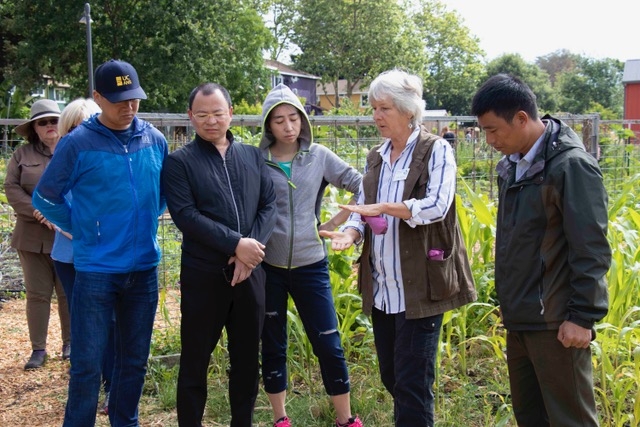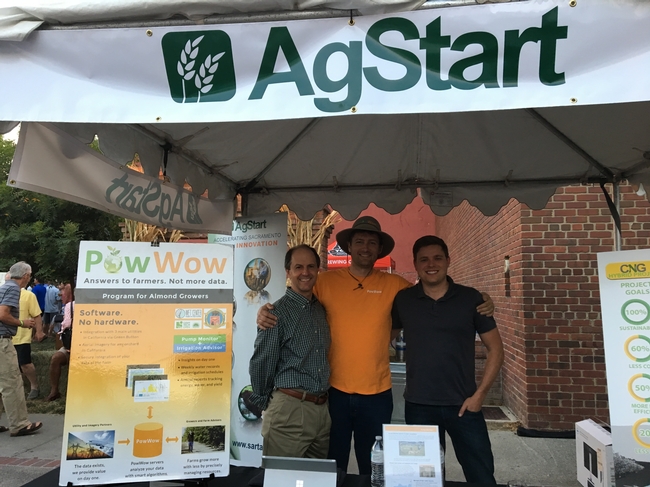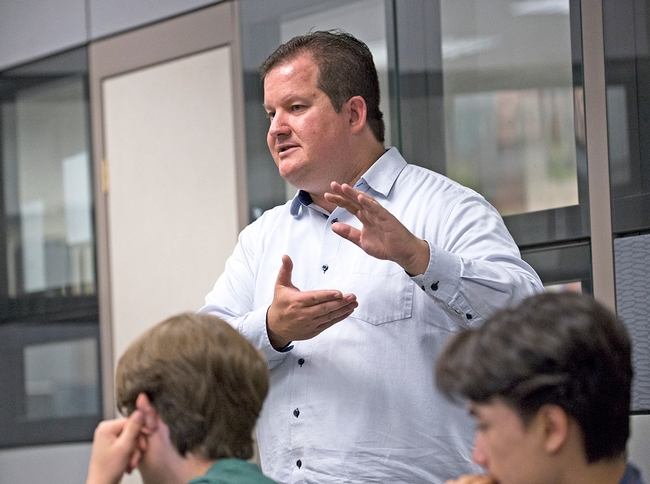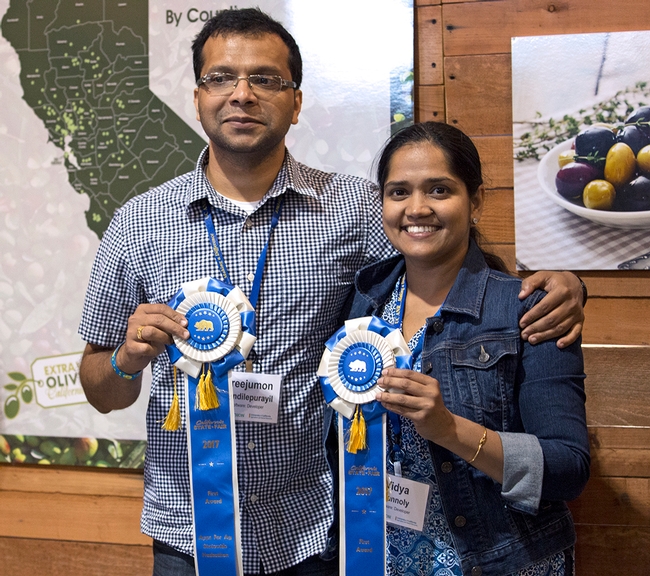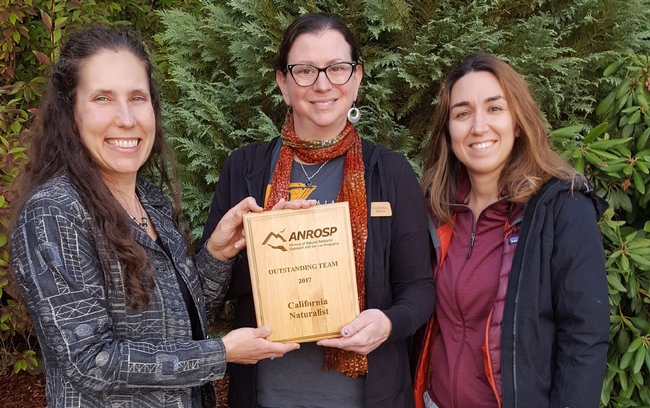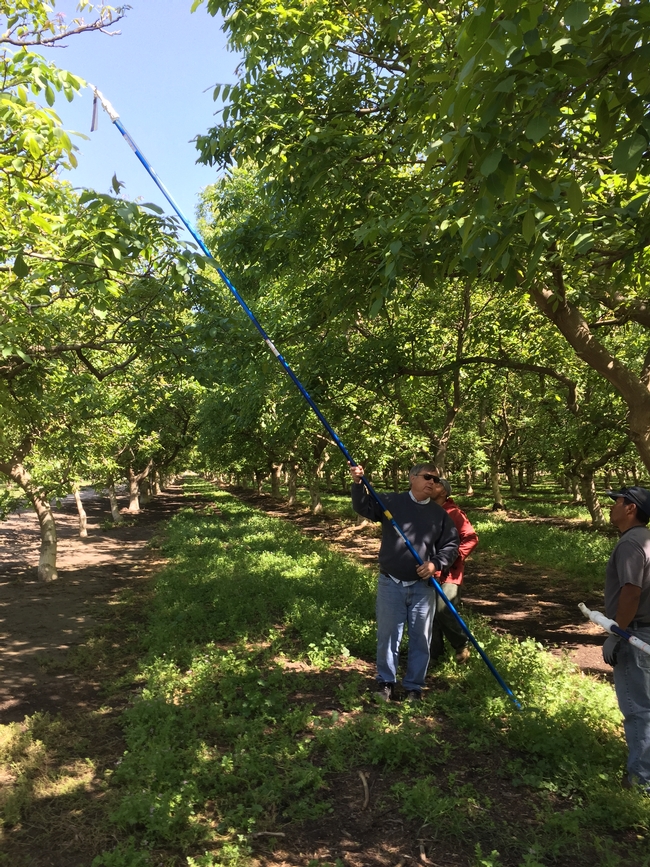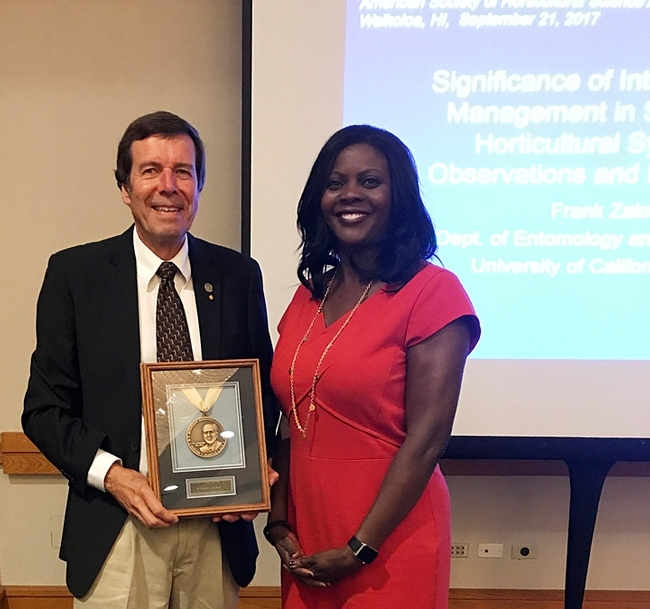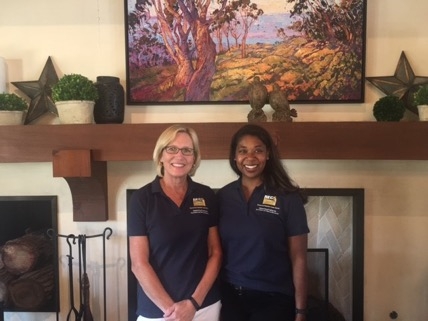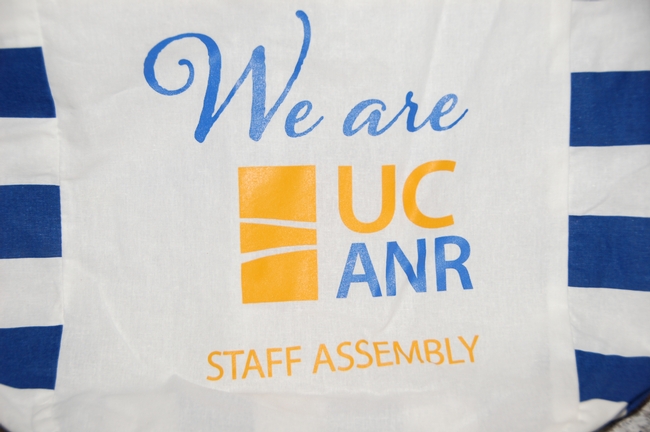Posts Tagged: Rob Wilson
Intermountain REC brings state-of-the-art conferencing to Tulelake
Intermountain Research and Extension Center (IREC) celebrated the grand opening of a multipurpose conference and laboratory building on July 26. The facility will be available for use by private and public groups for business meetings, job fairs, trainings and conferences.
"The facility is the first in the Tulelake area to offer modern audio-visual infrastructure and high-speed internet connectivity capable of supporting remote presentations to stay in touch with groups from around the world," said Rob Wilson, IREC director. "We hope this facility will greatly increase the visibility and accessibility of local events and help draw more regional attention to the area."
The conference room was dedicated in honor of the late John Staunton, a local research collaborator with UC Agriculture and Natural Resources who passed away in 2015. Staunton Farms and the Staunton family donated $25,000 to support the building project and recognize the Tulelake farmer and his long-standing support of agriculture and research.
Winema Elevators/Western Milling, Sensient Natural Ingredients, Macy's Flying Service, and Basin Fertilizer also contributed support.
UC awarded approximately $2 million for this capital improvement project with funds from UC lease revenue bonds to pay for most of the building's design and construction costs, but additional support is needed to complete the project. Intermountain REC has set a fundraising goal of $100,000 to pay for tables, chairs, furnishing and lab equipment for the building.
A special UC fund has been created to collect tax-deductible contributions to be used solely for this building project. Donations over $50 will receive recognition in print and on the IREC website. Donations over $1,000 will receive recognition on the donor wall in the building entryway. Name plate recognition on the donor wall will be based on the gift amount: Gold ($2,500+), Silver ($1,750 to $2,499), and Bronze ($1,000 to $1,749). Donations can be made via check using the enclosed envelope or by credit card by visiting the IREC website at http://irec.ucanr.edu and clicking the “Make a gift” link.
The ribbon cutting followed the 2018 IREC field day, an annual event that showcases the research underway at the 140-acre facility. Charlie Pickett of USDA, UC Davis Plant Breeding Center director Charlie Brummer, UCCE farm advisors David Lile and Rachael Long and UCCE specialist Dan Putnam joined Wilson in giving research updates on the tour.
Research presentations included work on biological control of cereal leaf beetle, influence of fall harvest management of irrigated grass hays, onion white rot, managing alfalfa weevil and clover rootcucurlio, pulse crop options for theKlamath Basin, cover crops and amendments, cutting schedule effects on lowlignin alfalfa andgermplasm evaluation of alfalfa and tallfescue.
Reporter Danielle Jester, who covered the events for the Siskiyou Daily News, noted the palpable absence of the late Steve Orloff, who was a UCCE farm advisor for Siskiyou County for 25 years. “Orloff's absence was noticeably felt throughout the day,” she wrote. “He passed away in October of 2017, and his influence in Siskiyou County's ag industry was very apparent, evidenced in part by the many mentions of his name and work throughout the day. IREC paid tribute to Orloff in the final page of its field day guide, which featured a full-page image of Orloff during a previous field day, with the words, ‘We miss you, Steve.'”
In the news article, Jester also wrote, “The information gleaned through research at the IREC can be invaluable to farmers and other researchers. Through its years of experimentation, the center has helped growers develop more effective practices in a wide range of areas, from determining the crops that will grow best in the local climate, to selecting the most economically viable crops for the region, to understanding the most effective ways to manage pests and disease.”
Chinese scientists tour California agriculture with UC ANR
To promote the exchange and sharing of agricultural extension information, several U.S. Land Grant institutions have formed an alliance with 10 Chinese agricultural universities. From June 17 to 22, UC ANR took a group of scientists from Chinese agricultural universities on a tour of agriculture in Northern California.
“The Chinese face many of the same issues that we do here in the U.S.,” said VP Glenda Humiston. “The Chinese universities want to improve rural economic development to lift up the quality of life for people in rural communities. They are also responding to global climate change, drought and pests while trying to improve food security and water use efficiency. They see UC Cooperative Extension as an effective research model; we hope that scientific collaborations will accelerate solutions and help maintain relations for California agriculture with China.”
The Chinese Extension Alliance Delegation included Song Hui, vice dean of the New Rural Development Research Institute of Northeast Agricultural University; Sun Wenpeng, professional extension personnel of Northeast Agricultural University; Luo Jian, associate professor of business at Hunan Agricultural University; He Minghui, associate professor of business at Hunan Agricultural University; and Li Peng, director of the Office of Invigorating Agriculture with Science and Education in the Department of Science and Technology.
The group toured Oregon agriculture with Oregon State University representatives, then drove from Klamath Falls with Humiston and Greg Gibbs and Rob Broadhurst of Development Services to begin the California tour at UC ANR's Intermountain Research and Extension Center in Tulelake. Rob Wilson, Intermountain REC director, showed them research being conducted on potatoes and mint breeding. From there, the group headed out to tour Shasta Dam.
In Redding, Larry Forero, UCCE director in Shasta County, and Rick Satomi, UCCE forest advisor, told the Chinese delegates about local research and outreach, then introduced them to 4-H youth and families at the Shasta District Fair, where 4-H members were bringing livestock for show.
UCCE advisors Josh Davy and Allan Fulton discussed orchards and water in Tehama County.
In Yuba City, UCCE director Janine Hasey and her staff gave the guests an overview of UCCE programs in Yuba and Sutter counties and plans for celebrating the office's 100th anniversary on Aug. 24. They met with UCCE pomology advisors, who gave them a tour of Sierra Gold Nurseries orchards and walnut rootstock research sites and discussed collaborations with growers.
Stephanie Larson, UCCE director in Sonoma County, drove the group around areas in Santa Rosa that burned in October and discussed UCCE's fire research and outreach to the community. The group also met with UCCE staff in Sonoma County to discuss food access, 4-H youth development, natural resources and wine grapes.
For a view of UC Cooperative Extension from the campus perspective, Mark Bell, vice provost of Strategic Initiatives and Statewide Programs, introduced the group to colleagues in the College of Agricultural & Environmental Sciences at UC Davis. They met with Mimi Rose, program coordinator for international programs; Martin Smith, UCCE specialist in the Department of Human Ecology; Ron Tjeerdema, associate dean for Environmental Sciences; Bruce Linquist, UCCE rice specialist; Jim Hill, emeritus UCCE specialist; and Louise Ferguson, UCCE specialist and founder of the Fruit and Nut Research and Information Center.
Anne Megaro, director of governmental and community relations, introduced the group to Gail Feenstra, deputy director and food systems coordinator of UC ANR's Sustainable Agriculture Research and Education Program, and Sonja Brodt, academic coordinator. Then they toured the Russell Ranch Sustainable Agriculture Facility with soil science post-doc Daoyuan Wang and the UC Davis Student Farm with its director Katharina Ullmann.
“They have extension in China, but it is not like ours,” said Megaro. “They are looking to strengthen their advisor positions and develop a mechanism for career advancement, similar to what we have in the U.S.”
The Chinese Extension Alliance Delegation wrapped up their tour at UC ANR's offices in Davis to learn about UC ANR's statewide programs. Jim Farrar discussed the Statewide Integrated Pest Management Program, Missy Gable described the Master Gardener Program, Shannon Horrillo talked about the 4-H youth development program, Greg Ira explained California Naturalist; and Katie Panarella covered the Nutrition, Family and Consumer Sciences, Expanded Food Nutrition Education (EFNEP) and Master Food Preserver programs.
Humiston, who met with the China-US University-based Agricultural Extension Alliance in China in March of 2017, said, “We look forward to collaborating with our agricultural extension colleagues in China.”
See more photos of the tour at https://www.flickr.com/gp/151501801@N07/YVBqk6.
UC ANR and AgStart receive $500,000 to cultivate the VINE
California is constantly being challenged by pest invasions, obesity, labor shortages, water scarcity, food insecurity, climate change and more. To accelerate the development and adoption of technologies that address these challenges and advance food, agriculture and natural resources in California, UC Agriculture and Natural Resources and AgStart will receive a $500,000 grant from the U.S. Economic Development Administration (EDA) to cultivate the Verde Innovation Network for Entrepreneurship (the VINE).
Like a grapevine, the VINE will connect existing clusters of innovation across California and link entrepreneurs with mentors, advisors, collaborators, events, competitions, education and other services to turn good ideas into products and services people can use.
“We want to make sure every Californian has the support system to take a novel idea and commercialize a new product or start a new business,” said VP Glenda Humiston. “They don't have to be a university inventor, they could be a farmer or a young person.”
AgStart itself was established with an EDA i6 Challenge grant to assist agriculture and food technology entrepreneurs in the Sacramento Valley region. Since 2012, AgStart has supported more than 58 entrepreneurs and their companies.
“In 2016, of the 16 entrepreneurial companies that AgStart assisted, eight resided outside our region, and leveraged AgStart's program to make connections into our Sacramento Valley region,” said John Selep, president of AgTech Innovation Alliance, AgStart's sponsor.
“The VINE will expand this AgStart model of connecting entrepreneurs to the resources they need to be successful, to enable entrepreneurs residing anywhere in California to connect to the clusters of resources, contacts, mentors and potential partners that have emerged across the state,” said Selep.
“There are many wonderful regional innovation hubs in food, agriculture and natural resources so we plan to bring value by amplifying their efforts, connecting regions and organizations into a more cohesive ecosystem, and bringing value-added resources that ultimately benefit all Californians through the innovations affecting our economic prosperity, food supply and environment,” Youtsey said.
UC Cooperative Extension specialists and advisors, who work in every county, can provide insight into real-world conditions that entrepreneurs should consider in the development stage. UC ANR's nine research and extension centers can provide locations to field-test products and demonstrate their effectiveness. For example, start-up Blue River is testing its technology by flying a drone over sorghum crops to collect data at the UC Kearney Agricultural Research and Extension Center in Parlier.
For the last two years, UC ANR has hosted the Apps for Ag hackathon and has introduced the winners to mentors, tech industry advisors, farmers, funders and legal experts who can advise entrepreneurs on business structure.
The VINE, which is working with UC Davis Innovation Institute for Food and Health and Valley Vision, is being structured to complement other efforts to establish food, agriculture, and natural resources incubation and innovation resources in cluster locations around the state, such as the BlueTechValley Regional Innovation Cluster, the Western Growers Innovation & Technology Center, UC Merced's VentureLab and others.
Youtsey and Selep are seeking more VINE partners with expertise across the business spectrum.
“If our vision is successful, the VINE will make California the most fertile region in the world for entrepreneurs in ag and food technology to establish themselves, to prosper and grow,” Selep said.
Names in the News
Slattery rejoins UCCE in Butte County
Chelsey Slattery rejoined UC Cooperative Extension on Sept. 18, 2017, as an area nutrition, family, and consumer sciences advisor in Butte County.
From 2013 to 2016, Slattery was a UCCE community education specialist, supervising the UC CalFresh Nutrition Education Program in Colusa, Sutter and Yuba counties.
From July 2016 to September 2017, Slattery was a program manager at UC Davis Center for Nutrition Schools, where she oversaw a statewide, multi-component, evidence-based, and research-tested nutrition education program. She facilitated training in coordination with the UC CalFresh State Office and UC CalFresh counties throughout the state of California.
Concurrently, Slattery has been working as a per-diem nutrition specialist since 2015 at Shady Creek Outdoor Education Foundation, where she provides oversight and guidance for the Fit Quest program, bringing comprehensive children's wellness programs to Northern California schools.
Slattery earned an M.S. in organizational leadership from the School of Business Management at National University. She completed a B.S. in exercise physiology/exercise science from CSU Chico.
Based in Oroville, Slattery can be reached at (530) 538-7201 and cslattery@ucanr.edu.
California Naturalist wins ANROSP outstanding team award
The California Naturalist Program was named the 2017 Outstanding Team by the Alliance of Natural Resource Outreach and Service Programs (ANROSP). Sabrina Drill, associate director of California Naturalist and UC Cooperative Extension advisor, and Marisa Rodriguez, community education specialist with California Naturalist in Southern California, accepted the award on Sept. 21 at the annual ANROSP conference held at the World Forestry Center in Portland, Ore.
Led by director Adina Merenlender, a UC Cooperative Extension specialist at UC Berkeley, the CalNat staff includes Greg Ira, academic coordinator; Brook Gamble, community education specialist; Drill and Rodriguez.
Teamwork is fundamental to the program structure. Since 2012, California Naturalist has certified more than 1,800 Naturalists, who have logged over 100,000 volunteer hours.
The team credits its success to the support and efforts across UC ANR and an extended team of course partners, instructors, statewide partners, educators, scientists, conservation practitioners, and many others who have contributed to the continued adaptive development of the program.
Grant to be inducted into Ag Hall of Fame
On Oct. 19, Joseph Grant, UC Cooperative Extension advisor emeritus, will be among the people inducted into the San Joaquin County Agricultural Hall of Fame at the 33rd Annual Agricultural Hall of Fame Banquet.
For most of his career, Grant, who retired in 2016, worked as a UC Cooperative Extension farm advisor and is known for his research on walnuts, cherries, apples, olives and other tree crops.
“It's kind of awesome. I mean when you look at the other people that have been inducted into the Hall of Fame, I don't consider myself in that class of people so it's humbling,” Grant said about his induction to the Lodi News-Sentinel.
In addition to Grant, the San Joaquin County Agricultural Hall of Fame will honor Henry “Skip” Foppiano, Jack and Pati Hamm and Hank Van Exel, and give a posthumous honor to winemaker Robert Gerald Mondavi.
According to the Hall of Fame, it “honors those individuals who have contributed to agriculture and to their community in significant ways.”
The banquet will be held at the Robert J. Cabral Ag Center in Stockton. Tickets are $45 and can be purchased by calling the Greater Stockton Chamber of Commerce at (209) 547-2770 or by visiting http://stocktonchamber.org/ag-hall-of-fame.
USDA-ARS bestows B.Y. Morrison Medal on Zalom
Frank Zalom, UC Davis distinguished professor of entomology and integrated pest management (IPM) specialist, has been named the recipient of the 2017 B.Y. Morrison Medal by U.S. Department of Agriculture/Agricultural Research Service (USDA-ARS).
Zalom is the first entomologist to receive the coveted award established in 1968, according to Kim Kaplan of the USDA-ARS Office of Communications.
Zalom was singled out for his outstanding work in IPM related to sustainable horticulture production, specifically for “his outstanding leadership and public service in IPM for horticultural crops at the regional, state, national and international levels; his stellar accomplishments in horticultural crops sustainability and pest management and his work ethic, service, courage and integrity, all driven by his insatiable curiosity and passion to solve problems in the horticultural crops landscape,” Kaplan said.
Zalom received the award, co-sponsored by USDA-ARS and the American Society for Horticultural Science (ASHS), on Sept. 21 at the ASHS conference in Waikoloa, Hawaii. He presented the Morrison Memorial Lecture on “Significance of Integrated Pest Management to Sustainable Horticultural Production – Observations and Experiences.”
Read more at //ucanr.edu/blogs/blogcore/postdetail.cfm?postnum=25218. -- Kathy Keatley Garvey
UC ANR Staff Assembly Updates
Ambassadors Meeting
The UC ANR Staff Assembly Council will hold a Staff Assembly Ambassadors meeting at the ANR Building in Davis on Oct. 10. The engagement will provide an opportunity for ambassadors to visit and network with colleagues and review Staff Assembly priorities. Additionally, they will discuss opportunities for staff to become more involved in addressing staff concerns and furthering organizational goals.
UC ANR Tote Bags
In an effort to help spread the word about UC ANR Staff Assembly, all Staff Assembly members will receive a We Are UC ANR Staff Assembly tote bag. Members of the UC Staff Assembly include all ANR staff, whether employed by the county or the university, represented by a union or not represented. UC ANR Staff Assembly Ambassadors are the points of contact for distributing the bags at each office.
CUCSA Fall 2017 Meeting
UC San Diego was the site of the CUCSA (Council of University of California Staff Assemblies) Fall 2017 Meeting Sept. 6-8. The meeting included a team building exercise, work group action planning, post retirement health benefit discussions and a review of UC Employee Engagement Survey results. UC ANR junior delegate LeChé McGill and senior delegate Jeannette Warnert represented UC ANR staff at the meeting.
On the subject of potential changes to post-retirement health benefits, CUCSA chair Lina Layiktez provided the summary below and links for more information.
Proposed change to post-retirement health benefits
The proposed action item for the July 2017 Regents meeting was to remove the 70 percent floor on the UC contribution to retiree health benefits and place a cap of 3 percent on year-over-year increases to UC costs. This is a policy change to offset the accounting rule changes required in "GASB 75." GASB 75 requires that the full actuarial value of other postemployment benefits (OPEB) be included on the systemwide balance sheet. This means that UC will have a perceived “new” liability of $21 billion, which would affect the system's overall credit rating. A hit to the UC's credit rating has obvious impacts to financing for the university.
The “new” GASB 75 requirement definition is subject to interpretation, since it was already a liability that was disclosed in previous year's financials. The value of this liability under current assumptions/retiree rules is approximately $21 billion. The current assumptions are being driven by the number of retirees in the system plus the number of potential retirees (active staff and faculty) and how much it would cost the system in health-care costs should the current employees retire today.
What does this all mean?
By removing the floor and capping UC's costs, the university effectively transfers rising health-care premiums to retirees. The assumed rate of health-care cost increase is 7 percent. Over the course of 20 years this would flip the proportion that UC pays to ~30 percent and the retiree to ~70 percent. The 70 percent floor was designed to provide some stability to retiree health-care costs.
What do we see happening?
Many UC employees choose to retire after calculating their retirement income. This is necessary because, except for Cost of Living Adjustments (COLA), there is no way for retirees to increase their income from the university. So when out-of-pocket health-care costs go up for retirees, this eats into their living expenses. There are already retirees and survivors of retirees who have to choose between health-care costs and food. To suddenly remove the 70% floor exacerbates this problem.
What can you do?
The campus staff assemblies are collecting feedback locally and sharing this up to the Council of UC Staff Assemblies (CUCSA), who will be coordinating a response to the UC President and/or Board of Regents. We are also working on a list of questions that include queries, such as what OPEB would look like if it grandparented current employees and implemented the changes to future retirees? What does this mean for retention of employees with 10 to 20 years of service?
The most powerful and helpful thing for us now is to hear about your personal concerns and how this impacts you. Would no OPEB mean you are less likely to retire from the UC system and take a job elsewhere for more money now? Will you have to postpone your retirement if, in retirement, you will have to pay a greater portion of your OPEB than you had planned for under the current plan?
Share your questions and stories with us on the UC ANR Staff Assembly website.
What's next?
Fortunately, the July agenda was revised and this item was moved to the November meeting agenda. Moving the item to November will allow for more consultation and discussion. It is unknown what approach the UC Office of the President (OP) will take to solicit feedback and engage in discussion. But as that information becomes available, we will make sure to share it broadly. We are hopeful that CUCSA (and therefore a voice of staff) will be included in the discussions and that OP will convene a task force representing all parties that will be affected by the proposed changes. Stay tuned.
Click here for the original July Regents Meeting Agenda Item (F7), which was then revised to remove the discussion on the 70 percent floor.
The immediate past chair of the systemwide Academic Senate, Jim Chalfant, has already written a letter to the UC President on this issue. You can read it online here: http://senate.universityofcalifornia.edu/_files/reports/JC-JN-Retiree-Health.pdf.
We can work collectively to inform and educate staff on this important matter. We are stronger together and the more voices that participate, the louder the message will be to those making the decisions that affect all of us.
UC ANR human resources director John Fox also said one important point that isn't addressed in the CUCSA summary is Medicare coverage. “When a UC retiree enrolls in Medicare, the monthly medical premium costs are significantly reduced (both for the retiree and for UC). Much of the future liability that UC is trying to control (and the risk of high monthly costs for the retirees) is during the time between retirement from UC and the start of Medicare eligibility (typically age 65).”
If you would like to share your stories or post a comment on this proposed change, please fill out the form on the UC ANR Staff Assembly website. We will share comments and stories from UC ANR with CUCSA leadership, who will compile it with information from other campuses to share with the UC President and UC Regents.

